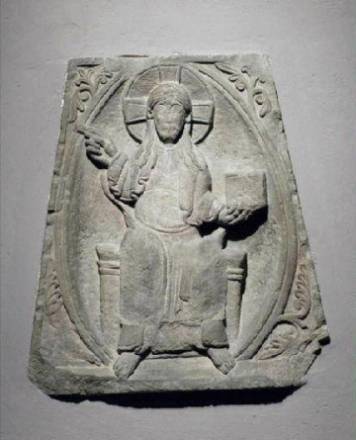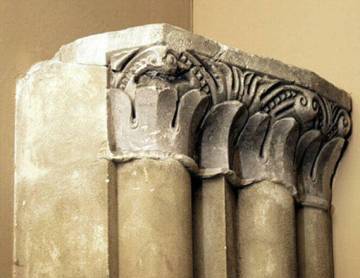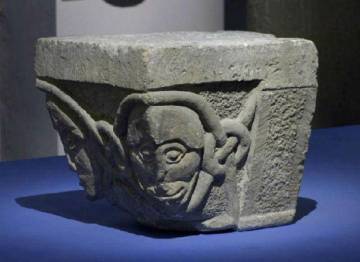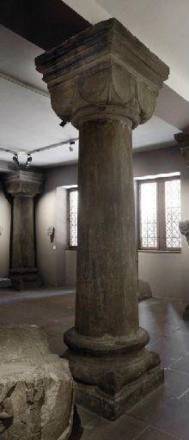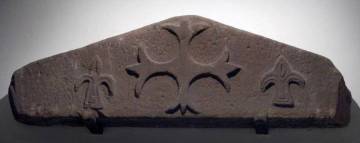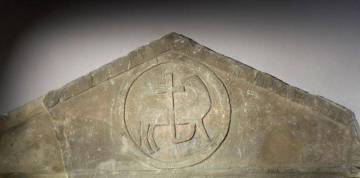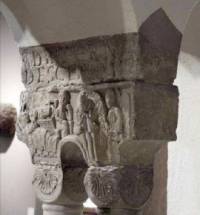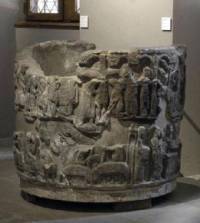Sculpture romane en Alsace
Développé tardivement en Alsace, l'art roman s'y manifeste durant les deux derniers tiers du 12e siècle et se prolonge jusqu'en 1230 environ. Voici une découverte des collections romanes du musée de l'Oeuvre Notre-Dame de Strasbourg, mises en ligne sur Joconde, catalogue collectif des musées de France.
Crédits : Ce contenu était originellement mis en ligne sur le site Joconde et a été constitué en 2009 par Cécile Dupeux, conservatrice au musée de l'Œuvre Notre-Dame à Strasbourg et Jeannette Ivain, service des musées de France. Les notices des collections citées sont en ligne sur POP, plateforme ouverte du patrimoine. Le lecteur est invité à consulter également les collections en ligne des musées de Strasbourg.
Genèse et développement de l'art roman en Alsace
Développé tardivement en Alsace, l'art roman s'y manifeste durant les deux derniers tiers du 12e siècle et se prolonge jusqu'en 1230 environ.
Cette période coïncide avec l'avènement dans la région des seigneurs de Hohenstaufen, ducs de Souabe et d'Alsace, puis rois et empereurs du Saint Empire romain germanique. Ils font profiter ce territoire de leur puissance et d'une exceptionnelle ouverture sur le monde, fondent et dotent de nombreuses églises et abbayes, et construisent une multitude de châteaux. Les vestiges, nombreux, témoignent de la prospérité de la région entre 1150 et 1250. C'est aussi à cette époque que les grandes
abbayes s'enrichissent et reconstruisent somptueusement leurs églises.
La sculpture n'apparaît que rarement sur les édifices du premier art roman, appelé sur le Rhin "art ottonien". Les huit colonnes provenant de l'ancienne église de Mutzig sont caractéristiques de cet art robuste, aux chapiteaux d'une grande simplicité et d'un type unique appelé "cube rhénan". Le 12e siècle voit l'épanouissement de la sculpture, qui ne peut être dissociée de l'architecture. Les portails des églises s'enrichissent et les chapiteaux se couvrent dès la fin du 11e siècle d'entrelacs, de rinceaux et d'animaux fabuleux comme en témoignent les chapiteaux de Blaesheim.
Cette production abondante voit l'évolution du traitement en méplat, de faible relief, comme sur les tailloirs du cloître d'Eschau jusqu'à la figure en ronde bosse, qui se déploie au transept sud de la cathédrale après 1210.
Les collections romanes du musée de l'Oeuvre Notre-Dame
La section romane du musée réunit un ensemble de statuaires (reliefs, têtes, plaques), d'éléments d'architecture (chapiteaux, tailloirs, colonnes, etc.) et d'objets d'église (bénitiers, cuves baptismales, lavabo, sarcophages) des 11e et 12e siècles provenant de différentes églises alsaciennes, ainsi que des vestiges de l'architecture civile.
Ces objets ont été en grande partie recueillis par la Société pour la Conservation des Monuments historique d'Alsace entre 1855 et 1916, puis déposés au musée de l'Œuvre Notre-Dame.
L'étude de la sculpture romane du musée a été menée avec la collaboration de Suzanne Braun, docteur en histoire de l'art, dont la thèse a porté sur l'art roman en Alsace.
Retrouvez les collections du musée de l'Oeuvre Notre-Dame sur Joconde.
Strasbourg
La cathédrale romane
Vers 1015, l'évêque de Strasbourg Wernher posa les fondations d'une basilique semblable à celles de Rhénanie. Terminée après 1050, elle fut agrandie à la fin du 11e siècle. Le chœur avec abside unique surmontait une crypte, tandis qu'à l'ouest s'élevait un massif monumental. De nombreux incendies entraînèrent la reconstruction complète de l'édifice en 1190. De la période romane subsistent les fondations (dégagées lors de fouilles entreprises entre 1907 et 1911), des parties du chœur et de la crypte.
Les vestiges romans de la cathédrale de Strasbourg conservés au Musée de l'Œuvre Notre-Dame proviennent soit du chœur, soit de la tour de croisée, soit des parties orientales, soit du cimetière et quelques autres emplacements.
Ils ont été excavés ou déposés lors de campagnes de restauration (notamment dans les années 1840).
Vestiges civils et religieux
Les travaux d'urbanisme à Strasbourg ont permis de mettre au jour des vestiges de l'architecture romane, sauvegardés pour la plupart par la Société pour la Conservation des Monuments historiques d'Alsace puis mis en dépôt au musée. Des fragments, tel celui d'un chancel, avaient servi de remploi et ont été retrouvés encastrés dans les murs de certains édifices.
Certains vestiges proviennent d'anciennes églises disparues comme l'église Saint-Martin, l'abbatiale Saint-Etienne, l'église rouge de Schiltigheim ou encore les parties romanes de l'église Saint-Pierre-le-Vieux. Un tailloir isolé provient du cloître roman de l'église Saint-Pierre-le-Jeune.
D'autres fragments témoignent de l'architecture civile comme la chapelle de la rue de l'Ail, la maison canoniale "Au Romain " et des encadrements de fenêtre.
Découvrez les vestiges romans de Strasbourg sur Joconde.
Eglise de Mutzig
Eglise Saint-Maurice
Les restes de l'église Saint-Maurice de Mutzig (20 km à l'ouest de Strasbourg), démolie en 1879, sont des témoins de l'architecture de la fin du 11e siècle et du milieu du 12e siècle. D'après les relevés et les dessins conservés, l'édifice était une basilique à trois vaisseaux de cinq travées, d'un chœur de plan carré, jouxté de chapelles latérales. Les vaisseaux étaient séparés par deux files de puissantes colonnes datant du milieu du 12e siècle, qui ont été conservées.
Malgré leur grande similitude (base attique massive, fût tronconique d'une pièce, chapiteau cubique sans sculpture), chaque colonne présente de légères différences. Les bases sont de deux types. Les chapiteaux appartiennent au type "cube rhénan", mais se différencient : deux sont à double lobe, six à lobe unique. Sur ces derniers, les motifs géométriques placés aux angles varient.
Le rejet de la sculpture monumentale ainsi que le goût pour la mouluration et les chapiteaux cubiques lisses, ciselés, se retrouvent dans la crypte de la cathédrale de Strasbourg (vers 1150) et à l'abbatiale de Niedermunster.
Linteaux de porte
De l'église de Mutzig proviennent également trois linteaux de porte, témoins de l'évolution de la sculpture romane du méplat de faible relief au moyen relief :
- un linteau orné d'une croix ancrée, flanquée de lis. La croix symbolise le Christ et les lis les arbres du Paradis où le Christ accueille les bienheureux. Thème que l'on retrouve sur le linteau de BergholtZell.
- le linteau en bâtière du portail occidental est orné d'un Agnus Dei en taille d'épargne. Pour une part incomplète, l'inscription qui court sur la bordure semble devoir se transcrire comme suit : (+IIT /// AD)ELBERTUS PRESPITER + CO(N)S(TR)VIT et rappelle la construction par le prêtre Adalbert.
- un bas-relief trapézoïdal figurant le Christ en majesté, assis sur un trône. La dalle était encastrée dans le mur extérieur de l'abside de l'église. Datant du milieu du XIIe siècle, elle marque un progrès dans le rendu du volume et semble appartenir à l'atelier de l'église Sainte-Richarde d'Andlau.
Découvrez les vestiges romans de Mutzig sur Joconde.
Abbaye d'Eschau
Eglise Saint-Trophime
Au 8e siècle, les évêques de Strasbourg fondèrent un couvent de femmes sur l'île d'Eschau à 10 km au sud de Strasbourg. L'église fut placée sous le double patronage de saint Trophisme, évêque d'Arles, et de sainte Sophie.
Détruite dans le premier tiers du 10e siècle, elle fut reconstruite au cours du 11e siècle, période faste du couvent. Le cloître fut démoli en 1298, ce qui marqua le début du déclin du couvent.
L'abbaye fut supprimée en 1526 et les bâtiments servirent de restaurant jusqu'en 1822.
L'église est encore en place et se développe sur un plan basilical à trois vaisseaux avec abside centrale et transept très saillant.
Vestiges du cloître
Des vestiges du cloître ont été retrouvés à l'occasion de fouilles menées par la Société des Monuments historiques d'Alsace en 1866 et 1916-1917. Les éléments les plus intéressants sont les tailloirs traités en faible relief et représentant des scènes de la Nativité et de la vie du Christ, ainsi que des figurations symboliques d'animaux et de plantes. Les inscriptions sur les sommiers se rapportent à des tailloirs disparus représentant des scènes de la Multiplication des pains, de la Résurrection de Lazare, de la Descente aux Limbes et de la Visite des trois Marie au tombeau. Ces tailloirs sont exceptionnels car les tailloirs de cloîtres romans conservés sont rarement décorés.
A cela s'ajoute des fragments de colonnes et des chapiteaux cubiques ornés de palmettes, ainsi que quelques éléments d'architecture et un lavabo liturgique.
Cuve baptismale
Le sculpteur du cloître exécuta également le décor de la cuve baptismale, qui a été malheureusement mutilée lors du bombardement de 1870.
Ce décor n'est pas géométrique comme sur les autres cuves conservées au musée, mais figuratif : sont représentés sur deux registres les épisodes de la vie du Christ, de l'Annonciation à la Pentecôte.
L'ensemble de ces sculptures est dû à un atelier actif vers 1130, qui s'inspire à la fois de l'enluminure, de l'orfèvrerie et du travail de l'ivoire.
Découvrez les vestiges romans de l'abbaye d'Eschau sur Joconde.
Lieux de l'art roman
La majeure partie de la sculpture romane alsacienne, intimement liée à l'architecture, a disparu lors de destructions successives ou est toujours en place. Elle est donc encore visible sur les principaux édifices romans de la région, qu'ils soient religieux (Andlau, Betbur) ou civils (château de Girbaden). Elle fait référence à des sources orientales, paléo-chrétiennes et byzantines comme le montre le décor des couvercles de sarcophages (Strasbourg, Mutzig, Bergholtz).
Partager la page
